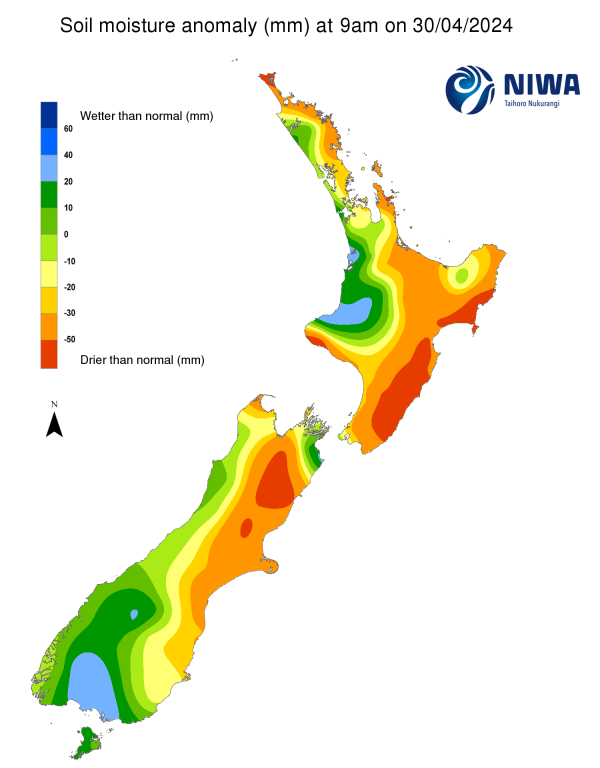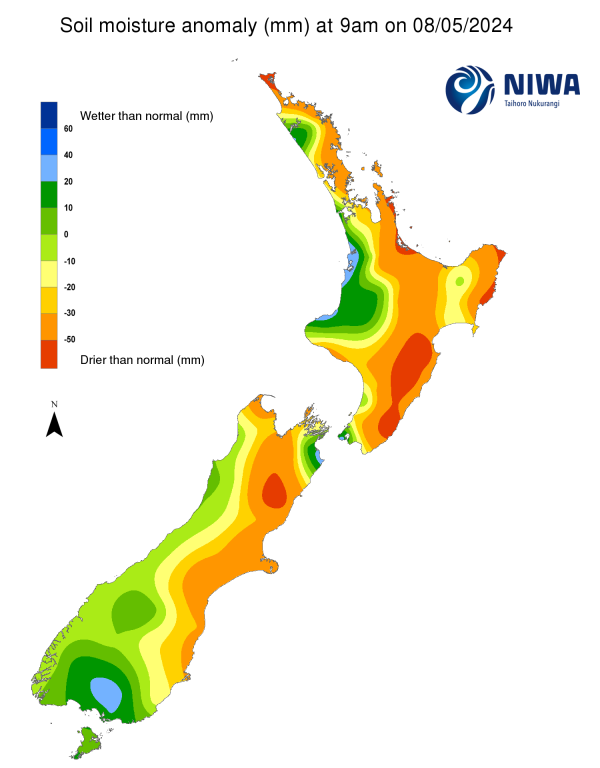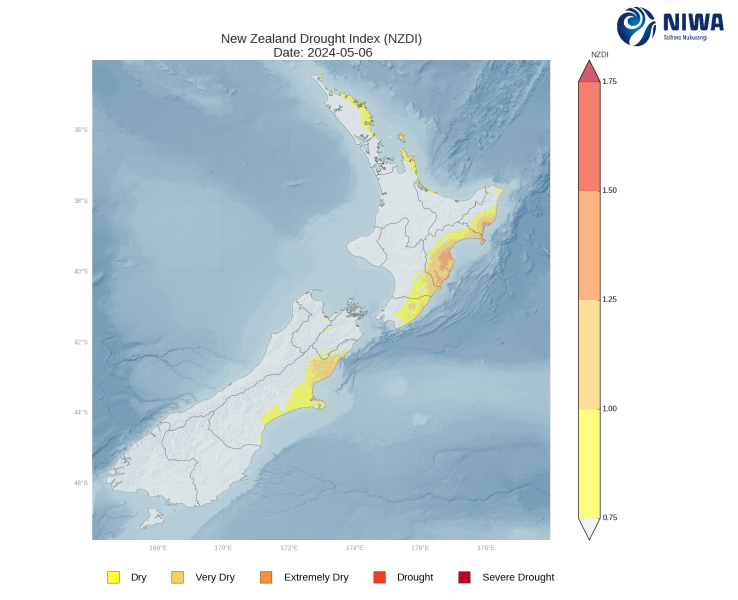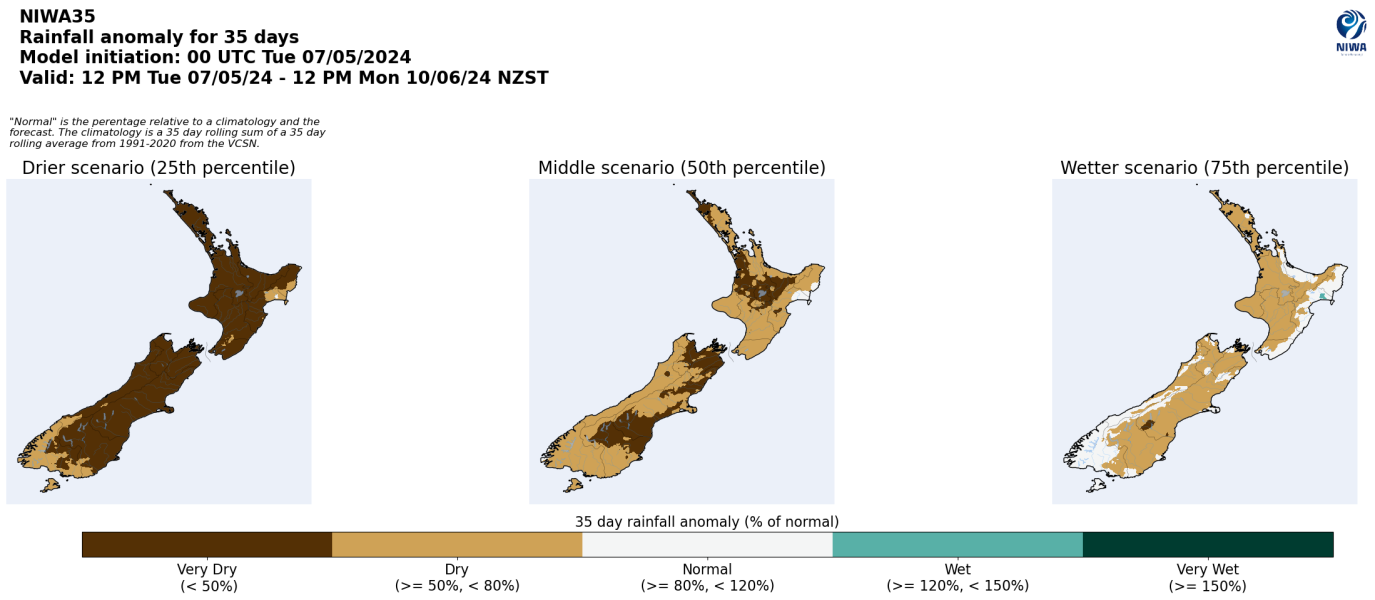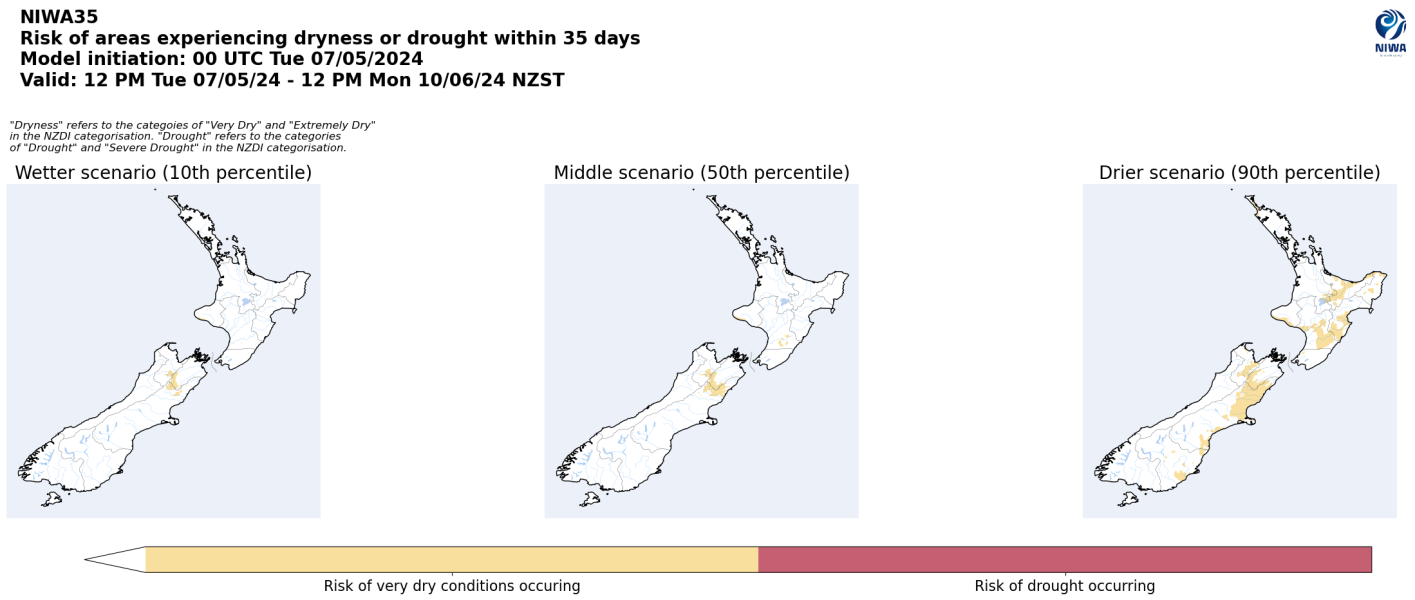Regions experiencing significant soil moisture deficits are deemed “hotspots”. Persistent hotspot regions have the potential to develop into drought.
Recent rainfall and current soil moisture conditions:
North Island:
- Most of the North Island saw rainfall totals of 5-15 mm in the past week, with isolated areas of 20-30 mm in Waikato, Taranaki, Bay of Plenty, Gisborne, and Wellington.
- Small soil moisture decreases were observed across many regions, with small increases occurring in interior Gisborne and from Taranaki to Wellington.
- The driest soils across the North Island, when compared to normal for this time of the year, are found near Cape Reinga, western Bay of Plenty, and along much of the east coast, while the wettest soils for this time of the year are found in western Waikato and northern Taranaki.
- Hotspots remain in place around Napier and Hastings in Hawke’s Bay.
- As of 6 May, the New Zealand Drought Index (NZDI) map below shows that abnormally dry conditions are currently found in eastern Northland, the Coromandel Peninsula, and much of the east coast from Gisborne to Wairarapa. Very dry to extremely dry conditions are located in the eastern North Island as well.
South Island:
- Meagre rainfall occurred across nearly all of the South Island in the past week, with most locations receiving 5 mm or less.
- However, rainfall totals were a bit higher in Southland, where 15-30 mm was generally observed.
- This resulted in moderate soil moisture decreases across much of the island, although Southland saw only small changes.
- The driest soils across the South Island, when compared to normal for this time of the year, are found in northern Canterbury, while the wettest soils for this time of the year are found in interior Southland.
- Hotspots remain in place across much of central Canterbury and isolated parts of southern Canterbury.
- As of 6 May, the New Zealand Drought Index (NZDI) map below shows that abnormally dry conditions are currently found in northern and central Canterbury, and very dry to extremely dry conditions are located in northern Canterbury.
Pictured above: Soil Moisture Anomaly Maps, relative to this time of year. The maps show soil moisture anomalies over the past two weeks.
As of 6 May, the New Zealand Drought Index (NZDI) map below shows that abnormally dry conditions are currently found in eastern Northland, the Coromandel Peninsula, much of the east coast from Gisborne to Wairarapa, and northern and central Canterbury. Very dry to extremely dry conditions are located in the eastern North Island and northern Canterbury. Please note: some hotspots in the text above may not correspond with the NZDI map. This difference exists because the NZDI uses additional dryness indices, including one which integrates the rainfall deficit over the past 60 days. Changes are therefore slower to appear in the NZDI compared to soil moisture anomaly maps that are instantaneously updated.
The week ahead
North Island:
- Generally dry weather is expected for most of the North Island through the middle of next week as high pressure sits over the region.
- However, the immediate east coast may see a few showers on Saturday (11 May), with isolated showers along the west coast from Sunday to Tuesday (12-14 May).
- There are some indications that an area of rain may move across the upper North Island on Wednesday or Thursday (15-16 May), but confidence is low at this time.
- Weekly rainfall totals are again likely to be meagre across at least the central and lower North Island with amounts of less than 10 mm, while totals of 15-30 mm could occur in the upper North Island should the aforementioned area of rain eventuate.
- Due to the expected rainfall in the next week, additional soil moisture decreases will be likely across at least the central and lower North Island.
- The current hotspots located in Hawke’s Bay may not change significantly in the next week.
South Island:
- The South Island will also see meagre rainfall in the coming days, with only Southland receiving occasional showers during this time.
- From Tuesday (14 May), a series of fronts will bring some rain to the lower West Coast, Fiordland, and Southland, but other regions are likely to remain dry.
- Weekly rainfall totals of 40-75 mm will be possible in the lower West Coast and Fiordland, with up to 25 mm possible in Southland.
- However, the rest of the island may receive 5 mm or less, with some locations receiving no rainfall at all in the next week.
- Due to the expected rainfall in the next week, additional soil moisture decreases will be likely in many regions, with the best chance in the upper and eastern South Island.
- The current hotspots located in Canterbury may strengthen at least slightly in the next week.
Long-term outlook (through early June):
- The drier (25th percentile) and middle (50th percentile) rainfall scenarios both show below normal to well below normal rainfall widespread across nearly the entire country.
- Even in the wetter (75th percentile) scenario, below normal rainfall is signalled across large portions of both islands, increasing confidence in a below normal rainfall outcome in the coming weeks.
- Very dry soil conditions may affect parts of eastern New Zealand, particularly in the drier scenario.
Pictured above: 35-day forecast rainfall anomaly scenarios (Top), and 35-day forecast dryness and drought scenarios (Bottom). These maps are updated daily at https://niwa.co.nz/climate/seasonal-climate-outlook
Background:
Hotspot Watch: a weekly advisory service for New Zealand media. It provides soil moisture and precipitation measurements around the country to help assess whether extremely dry conditions are imminent.
Soil moisture deficit: the amount of water needed to bring the soil moisture content back to field capacity, which is the maximum amount of water the soil can hold.
Soil moisture anomaly: the difference between the historical normal soil moisture deficit (or surplus) for a given time of year and actual soil moisture deficits.
Definitions: “Extremely” and “severely” dry soils are based on a combination of the current soil moisture status and the difference from normal soil moisture (see soil moisture maps at https://www.niwa.co.nz/climate/nz-drought-monitor/droughtindicatormaps)
Hotspot: A hotspot is declared if soils are "severely drier than normal" which occurs when Soil Moisture Deficit (SMD) is less than -110 mm AND the Soil Moisture Anomaly is less than -20 mm.

